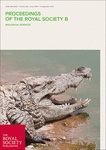67. Freshwater connectivity transforms spatially-integrated signals of biodiversity
Michael D. Rennie
 Littlefair, J.E., Hleap, J.S., Palace, V., Rennie, M.D., Paterson, M.J. and Cristescu, M.E. 2023. Freshwater connectivity transforms spatially-integrated signals of biodiversity. Proceedings of the Royal Society B, 290 (2006): 20230841. https://doi.org/10.1098/rspb.2023.0841
Littlefair, J.E., Hleap, J.S., Palace, V., Rennie, M.D., Paterson, M.J. and Cristescu, M.E. 2023. Freshwater connectivity transforms spatially-integrated signals of biodiversity. Proceedings of the Royal Society B, 290 (2006): 20230841. https://doi.org/10.1098/rspb.2023.0841 

